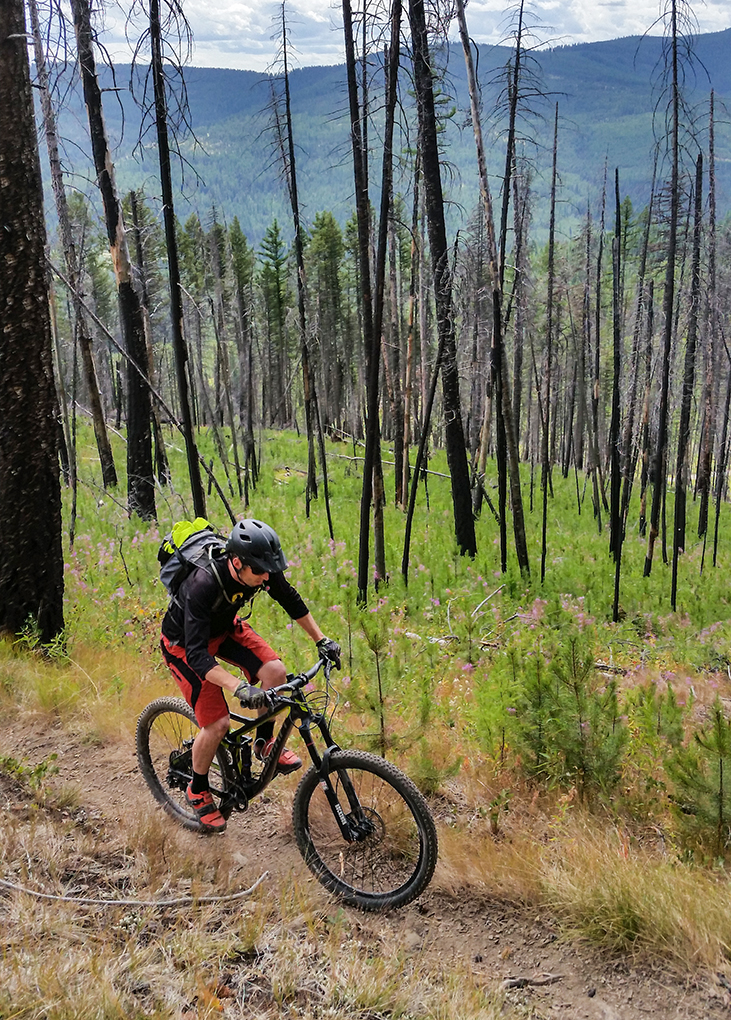The Ride
The first thing I noticed on the Troy was the fit; like I mentioned above, after finding my Medium Spartan to be a bit on the small side, I bumped up to a Large for the Troy. While I can have fun on both smaller and larger bikes, the extra stability that comes with a longer bike is certainly appreciated in a lot of situations.
After swapping out the stem (down to a 50mm), I was comfortable on the Troy. I didn’t feel too stretched out, and it afforded some extra room to shift my weight fore and aft on rougher trails. I was able to run the seat in the middle of the rails and still felt comfortable for lengthy stints of seated pedaling.
Once I was accustomed to the fit, I had to get the suspension sorted out. As I’ve noted, this was easier said than done. The Troy has a moderately progressive leverage curve (meaning that it’s a moderate falling rate), but it’s not quite as progressive as a number of other bikes out there (including the Spartan). It also has a moderately high leverage ratio at the beginning of its travel, which gives it a very supple ride over small bumps.
What this all adds up to is a very active suspension, but one that uses its travel very easily. Even running relatively little sag (~22%), I would still get deep into the travel on a regular basis, and bottom out on most hard hits.
By reducing the air volume on the rear shock, some of these issues were minimized, but I still wouldn’t say this is a bike that’s ideal for someone who’s inclined to huck to flat.
Now, to be clear, this bike isn’t really designed or marketed to the “h2f” crowd, and in the setting where this bike is intended to play, it does really well. When it comes to root-infested, rocky trails, the Troy does great. That supple suspension stays really active, and it irons out rough stuff impressively well.
Added to that is the bike’s geometry; the relatively slack front end and low-ish bottom bracket makes for a surprisingly stable ride when hammering through rough stuff. No, the Troy isn’t a replacement for a longer-travel “enduro” rig, but for a trail-oriented bike, it’ll rally through technical trails plenty fast.

And while it’s perfectly comfortable dropping the hammer in the rough, it still retains a nimble playfulness, similar to the Spartan. Rather than being a point-and-shoot plow bike, the Troy likes to pop off of rollers and flick around corners. This seems to be the story across many of the Split Pivot bikes I’ve ridden: they reward an active rider.
However, frame stiffness can become an issue when pumping and throwing the bike sideways, and fortunately, the Troy holds up well in this regard. The Troy isn’t quite as stiff as the decidedly overbuilt Spartan, but it’s still no noodle. There was an occasional hint of flex from the rear end, but it is by no means a bike that I would call flexy.
That active rear suspension does give up a bit of ground when the trail points uphill. Surprisingly, I think the Spartan actually pedals a bit better than the Troy, despite having a bit more travel. On the Spartan, I’m pretty content leaving the rear shock open for most climbs, but I found myself reaching down to firm up the shock quite often on the Troy.
If I’m going to play armchair engineer, I would guess that the Troy was designed around a double chainring setup, whereas the Spartan was probably designed around a single chainring.
I was running a single 32t ring on both bikes, and while that worked well on the Spartan, it wasn’t ideal on the Troy in terms of pedaling efficiency. Judging from the anti-squat curve, I’d bet the Troy would pedal a bit more efficiently if it was kitted out with a 2×10 setup and I was tackling those climbs in the granny ring.
That said, the upside of the Troy’s pedaling characteristics is that it remains very active, which is great for technical climbs. The Troy cruised up steep roots and rocks with relative ease. I also found that the geometry was such that I didn’t use the travel adjust on the fork very often, which is nice since I always forget to re-extend the fork before the descent.
The only downside here is that relatively low bottom bracket: pedal strikes were a bit of an annoyance, and more than once I found myself wishing that Devinci had spec’d the Troy with 170mm cranks rather than the 175mm cranks it had on it.
One of the main selling points of the Split Pivot linkage is its ability to dial in the bike’s handling under hard braking. On most bikes, grabbing a handful of brakes will make the rear suspension compress to some extent. Too much of that, and the bike gets too deep in its travel and has trouble absorbing bumps while on the brakes. Too little brake-induced compression, and the bike becomes unbalanced—the front suspension will compress as your weight shifts forward, but the rear end will stay high in its travel.
Finding the perfect middle ground is, to some extent, an issue of personal preference, but I found the Troy to be well balanced. It didn’t feel like the suspension became harsh while on the stoppers, but I also felt like the bike remained fairly composed in terms of fore-aft weight shifts, even when dragging brakes down steep terrain.
NEXT: Comparisons, Bottom Line
